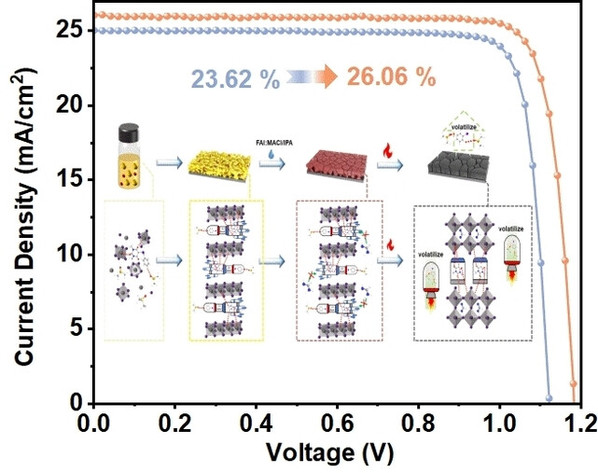Program-Modulated Kinetics of Perovskite-Film Growth by Molecular “Thruster” for High-Efficiency and Stable Perovskite Solar Cells
Chuanshuai Han1,2, Yeyong Wu1, Guiying Xu1(许桂英)*, Xiaoxiao Wu1, Jiacheng Xu1, Tingting Xu1, Shihao Huang1, Yunxiu Shen1, Zhiyun Cao1, Weijie Chen1, Xiaoping Xu2,5(徐小平)*,Yaowen Li1,3,4(李耀文)*
1Laboratory of Advanced Optoelectronic Materials, Suzhou Key Laboratory of Novel Semiconductor-optoelectronics Materials and Devices, College of Chemistry, Chemical Engineering and MaterialsScience, Soochow UniversitySuzhou 215123, China
2Laboratory of Organic Synthesis of Jiangsu Province, College ofChemistry, Chemical Engineering and Materials Science, Soochow University, Suzhou 215123, China
3Jiangsu Key Laboratory of Advanced Negative Carbon Technologies, Soochow University Suzhou 215123, China
4State and Local Joint Engineering Laboratory for Novel Functional Polymeric Materials, Jiangsu Key Laboratory of Advanced Functional Polymer Design and Application, College of Chemistry, Chemical Engineering and Materials Science Suzhou 215123, China
5Innovation Center of Chemical Science, Soochow University,Suzhou 215123, China
Angew. Chem. Int. Ed. 2025, 64, e202419726
Abstract:The rapid reaction between lead iodide (PbI2) and formamidinium iodide (FAI) complicates the fabrication of high-quality formamidinium lead iodide (FAPbI3) films. Conventional methods, such as using nonvolatile small molecular additives to slow the reaction, often result in buried interfacial voids and molecule diffusion, compromising the devices’ operational stability. In this study, we introduced a molecular “thruster”—a hypervalent iodine (III) compound with three carbonyl groups and a C−−I+ bond—that possesses coordination and dissociation abilities, enabling programed modulation of perovskite-film growth kinetics. Initially, the three carbonyl groups coordinate with PbI2 to slow the reaction between FAI and PbI2, preventing δ-phase formation. As temperature rises, the C−−I+ bond dissociates, promoting perovskite growth and the dissociated product iodobenzene will promote solvent volatilization, thus avoiding buried interfacial voids. Another product, a carbene compound with eight lone pair electrons sufficiently passivate the undercoordinated Pb2+ defects and anchors at grain boundaries without diffusion. Consequently, the resultant FAPbI3 film displays high-quality with enhanced phase purity, compact morphology, and reduced defects. Evidently, 0.062- and 1.004-cm2 pero-SCs achieve power conversion efficiencies (PCEs) of up to 26.06 % (25.79 % certified) and 24.65 %, respectively. This approach also controls perovskite-film growth on plastic substrates, resulting in flexible pero-SCs with an impressive PCE of 25.12 %.

Article information: //doi.org/10.1002/anie.202419726